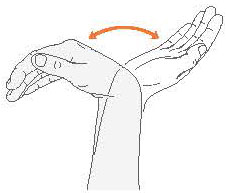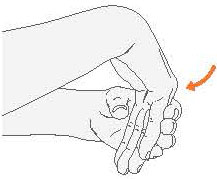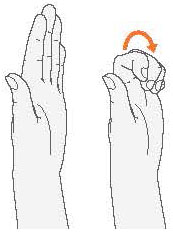This page provides general information about carpal tunnel syndrome and simple exercises that may help:
What is carpal tunnel syndrome?

Carpal tunnel syndrome is a condition in which the median nerve is squeezed where it passes through the wrist. This often happens because the tendons in the wrist have become swollen and they press on the nerve. The median nerve controls some of the muscles that move the thumb and it carries information back to the brain about sensations in your thumb and fingers.

When the nerve is squeezed it can cause pain, aching, tingling or numbness in the affected hand. The symptoms tend to be worse at night and may disturb your sleep, but you may notice it most when you wake up in the morning. Hanging your hand out of bed or shaking it around will often relieve the pain and tingling.
You may not notice the problem at all during the day, though certain activities – such as writing, typing, DIY or housework – can bring on symptoms.
Sometimes the condition can be mistaken for something else. For example, pressure on nerves in the neck due to disc problems or arthritis can cause similar symptoms.
A nerve conduction test may help if there’s any doubt about the diagnosis.
What causes carpal tunnel syndrome?
Carpal tunnel syndrome is a common problem. It’s often caused by work-related activities, such as typing, and repetitive movements, although some cases may be related to arthritis of the wrist, thyroid disease and pregnancy. Your risk of developing it may be greater if your job places heavy demands on your wrist
or if you use vibrating tools.
What can be done to help?
If there’s a particular cause, like an underactive thyroid or arthritis, treating that condition may help. Other treatment will depend on how severe the nerve compression is. It’s important to get help quickly if your hand muscles are weak.
Splints

Wearing a resting splint can help prevent the symptoms occurring at night, or a working splint can be useful if your symptoms are brought on by particular activities.
Your doctor or physiotherapist can advise on where you can be fitted with a splint.
Steroid injections
To reduce inflammation, your doctor or a specialist physiotherapist can give you a steroid injection into your carpal tunnel. The injection may be uncomfortable, but the effects can last for weeks or months.
A steroid injection into the wrist joint itself may help if you have arthritis in your wrist.
Your pain should ease within 2 weeks and you should recover over approximately a 4–6 week period.
You should use the exercises below for at least 6–8 weeks to help prevent symptoms returning.
Simple exercises
Wrist bend
(forward and back)

Rest your elbow on a table, arm pointing up, wrist straight.
Gently bend your wrist forward at a right angle and hold for 5 seconds.
Straighten your wrist.
Gently bend it backwards and hold for 5 seconds.
Do 3 sets of 10 repetitions.
Wrist lift

Place your palm on the table and lift the fingers up.
Place your other hand across the knuckles at 90º and push down as the bottom hand tries to pull up.
You should feel the muscles of your forearms contracting.
Swap hands and repeat.
Wrist flex

Keeping your arm straight in front with your palm facing down, gently bend your wrist down.
Use the opposite hand to press the stretching hand back towards your body and hold for 15–30 seconds.
Straighten your wrist.
Gently bend the stretching hand backwards and use the opposite hand to pull the fingers back.
Hold for 15–30 seconds.
Do 3 sets with each wrist.
Finger bend

Start with your fingers held out straight.
Gently bend the middle joints of your fingers down toward your upper palm and hold for 5 seconds.
Do 3 sets of 10 repetitions.
Wrist stretch with weight

Holding a light weight (e.g a tin of beans), stretch your arm out in front with your palm down.
Slowly bend your wrist upward, and then return to the starting position.
Do 3 sets of 10 repetitions.
Gradually increase the weight you hold.
Hand squeeze

Squeeze a rubber ball and hold for 5 seconds.
Do 3 sets of 10 repetitions.
Summary
- Carpal tunnel syndrome can usually be easily treated.
- Symptoms tend to be worse at night – hang your hand out of bed or shake it around to ease pain.
- Certain activities can bring on symptoms. Wearing a working wrist splint may be helpful.
- Try the exercises suggested here to help ease pain and prevent future injuries.
PDF version
To make it easier for you to print these exercises we have created a PDF version, suitable for home printing.
Acknowledgements
This content has been authorised for use by Versus Arthritis
More health advice
See our guides on:
- exercise advice
- sporting injuries
- keeping active and healthy